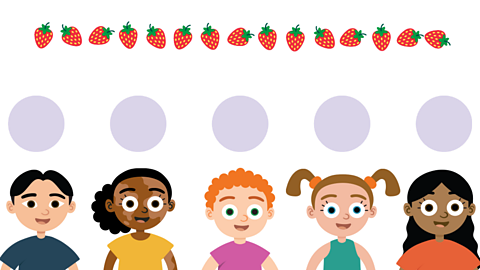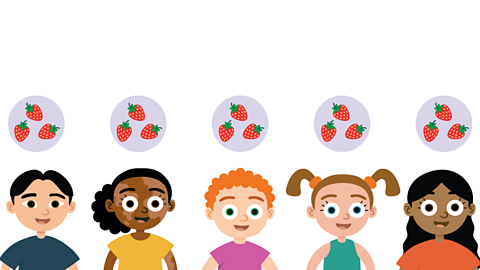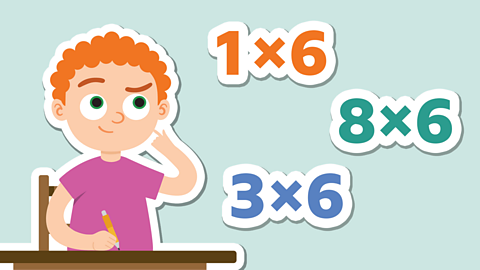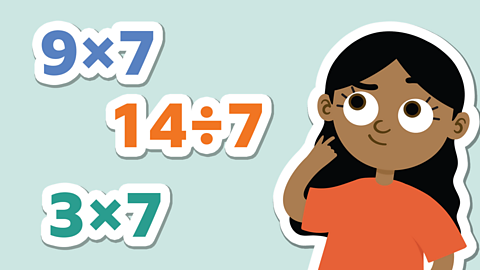Dividing by 5
You can think about dividing by 5 in two ways.
When you divide by 5, you either share the amount between 5 groups or you divide the amount into groups of 5.
For example, here are 10 counters.

You can share them into 5 groups and count how many counters are in each group. Like this:

Or you can divide them into groups of 5 and count how many groups you have. Like this:

Both ways will give us the same answer.
Quiz: Divide by 5
Why not see how much you know about this topic already? Then complete the guide and see if you can beat your score.
Sharing
You use the division symbol (÷) when you are writing division calculations.
Let’s solve this division problem. You are going to use sharing to help.
You have 15 strawberries. You want to share them equally between 5 five friends.
How many strawberries do they have each?

This is how you write the calculation.
15 ÷ 5 =

Image caption, To solve this, you are going to share the 15 strawberries equally between 5 friends, so you draw 5 sharing circles.

Image caption, Next, you share the strawberries between the 5 friends. Every friend must have the same number of strawberries.
1 of 2
You can see that each friend has 3 strawberries each.
15 ÷ 5 = 3
Grouping
Let’s solve the same calculation, but this time let's divide the strawberries into groups of 5.
This is called 'grouping'.
Here are the 15 strawberries again.

Let's divide them into groups of 5.
How many groups of 5 strawberries do you have?

There are 3 groups of 5 strawberries.
15 ÷ 5 = 3
Did you notice that you got the same answer for both problems?
That’s because the calculation is the same.
This means you can use sharing or grouping to solve division problems and you will get the same answer.
Using the 5 times table
You can use your knowledge of times tables and skip counting to divide by 5.
Let’s try the same question and see if we get the same answer!
15 ÷ 5 =
How many 5s are there in 15?
__ × 5 = 15
Try saying the 5 times table out loud to help you find the answer.

You can also use skip counting to help you. You can skip count in 5s until you get to 15.

Using the 5 times table, you know that:
3 × 5 = 15
Therefore:
15 ÷ 5 = 3
If it helps, you can always use your fingers to help with skip counting. Like this:

Example 1
Try this division problem.

Fred has 20 pencils and five pots. The 20 pencils need to be shared equally between the five pots.
How many pencils will be in each pot?
✓ Let's use sharing to solve this problem.
Below the 20 pencils have been shared equally. Each pot has 4 pencils in. So:
20 ÷ 5 = 4

Example 2
Maya is organising her 10 friends into teams of 5 to play a game.

How many children will be in each group?
✓ Let’s put the friends into groups of 5 and see how many groups there are.
You can see that there are 2 groups of 5 friends.
10 ÷ 5 = 2

BBC Bitesize newsletter. External LinkBBC Bitesize newsletter
Sign up to our BBC Bitesize newsletter to receive monthly news, stories and updates on latest Bitesize content.

More on Multiplying and dividing
Find out more by working through a topic
- count11 of 34

- count12 of 34

- count13 of 34

- count14 of 34
